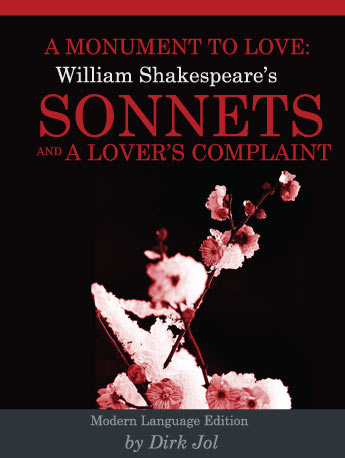A Monument to Love:
William Shakespeare’s Sonnets and A Lover’s Complaint
→ Biography of William Shakespeare


William Shakespeare’s Sonnets received only a single printing during his lifetime, a fate that poets in any age would understand. By , the sonneteering fashion had already largely passed, and the literary world was moving on to new challenges in the post-Elizabethan era. By this time as well, Shakespeare had written and performed most of his major plays and, at around 45 years of age, was about to retire to his home-town of Stratford for good.
Very little is known about the specific circumstances surrounding the Sonnets’ publication. Because two of the 154 sonnets were published in other books ten years before, it is likely that all or most of them date from that earlier time as well. It is not known whether Shakespeare even had a hand in printing them. We can only say that Shakespeare wrote them, although there are some who would dispute even that!
Some of the sonnets are well known because they are often part of English anthologies read at school. They are often required reading and, occasionally, the subject of memorization assignments. Sadly, even today, only specialists tend to read the Sonnets as a whole.
This Modern Language Edition of the Sonnets will appeal to readers who have difficulties with early modern English but still want to gain a strong grasp of the contents on first reading.
To whom the book was dedicated is a mystery. Elizabethan and Jacobean publishers frequently used the initials of people rather than giving their full names, even on title pages and in dedications. To compound matters further, writers were intent on creating literary realities that did not necessarily reflect their personal opinions or experiences. A minor academic industry has since been built on trying to identify the people and characters involved in this book.
Except for a few notable detours, the poet addresses the first 126 of the 154 sonnets to someone whom many later commentators have called ‘the fair youth’. Especially in the first 17 sonnets, the poet worries that the young man is wasting his life by not marrying and by not having children of his own. Sonnets 127 to 152 are addressed to a woman whom many later commentators have called ‘the dark lady of the sonnets’. The final poems in the sequence, sonnets 153 and 154, are two variations on the theme of Cupid’s role in human desire.
The publisher added a ‘bonus’ section in the form of a longer poem of 47 stanzas entitled A Lover’s Complaint. The publisher claimed that this poem was also written by Shakespeare, but critics remain divided over the authenticity of the claim. The sequence is included here for the sake of completeness.
Shakespeare structures his sonnets almost always in the same way: three four-line quatrains and a closing couplet, with a rhyme scheme of abab cdcd efef gg. The first quatrain usually (but not always) sets up a problem or situation, the second quatrain develops it, the third quatrain contains the response, and the closing couplet resolves or decides on the matter.
The original wording of Shakespeare’s Sonnets as published in 1609 is contained in the following downloadable PDFs:
You may purchase an ebook (epub or mobi) of the entire 1609 version in the original wording at a nominal cost of US $1.99 by clicking on the following button:
Colin Burrow, Shakespeare: The Complete Sonnets and Poems, Oxford: Oxford University Press, .
G. Blakemore Evans, The Sonnets, Cambridge: Cambridge University Press, .
Katherine Duncan-Jones, Shakespeare’s Sonnets, London, Methuen Drama, .
Edward Hubler, The Sense of Shakespeare’s Sonnets, New York: Hill and Wang, .
A.L. Rowse, Shakespeare’s Sonnets – The Problems Solved: A Modern Edition with Prose Variations, Introduction and Notes, .
Martin Seymour-Smith, Shakespeare’s Sonnets, London: Heinemann, .
Helen Vendler, The Art of Shakespeare’s Sonnets, Cambridge MA: Belknap Press of Harvard University Press, .